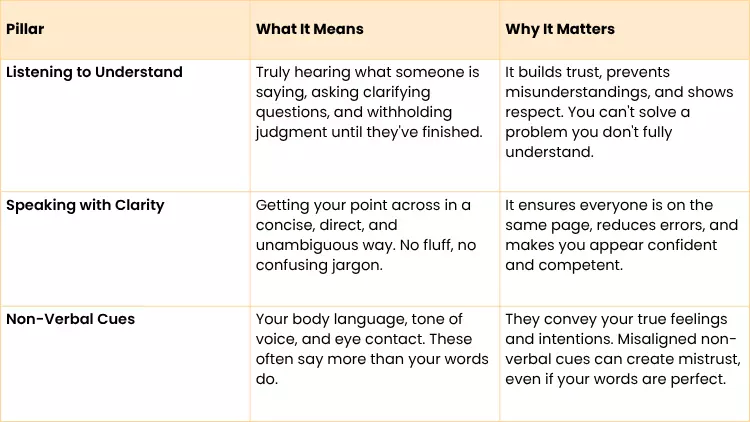How to Improve Communication Skills and Succeed

Improving your communication skills isn't about memorizing scripts or learning corporate jargon. It's about building a genuine ability to connect, persuade, and lead. At its core, this comes down to three things: listening to understand (not just to reply), speaking with impactful clarity, and mastering the silent language of non-verbal cues.
Jump To Section

Earn As You Learn
Earn 25% commission when your network purchase Uplyrn courses or subscribe to our annual membership. It’s the best thing ever. Next to learning,
of course.
Why Great Communication is a Career Superpower
We’ve all seen it happen. A project derails, a deadline is missed, or a team loses morale—all because of a simple misunderstanding. We often label communication as a “soft skill”, but in reality, it’s the hard-working engine behind every successful team and project. It's what separates a team that clicks from one that's plagued by constant friction.
Don't just take my word for it. The data is overwhelming. One recent report found that a staggering 86% of employees and executives blame ineffective communication for most workplace failures. On the flip side, getting it right can boost a team's productivity by as much as 25%. If you're interested in the numbers, this article has some great workplace communication insights.
To really improve, we have to grasp these foundational pillars. Think of them as the three legs of a stool—if one is weak, the whole thing becomes unstable.
Three Pillars of Effective Communication
Here's a quick breakdown of what these core concepts mean in the real world.
Mastering these pillars is what separates the average professionals from the truly influential ones.
This infographic really drives the point home, visualizing just how costly miscommunication can be and why these fundamentals are so critical.
The takeaway is simple: most workplace errors are preventable. Strengthening your communication skills is the most direct way to stop them before they start. It's so vital, in fact, that it's considered one of the magnificent seven soft skills that empower technical professionals.
So, let's move past the generic advice. This guide is your roadmap to becoming a communicator who truly makes an impact.

The Art of Listening to Understand
We've all been there. You're in a conversation, but you're not really in it. You’re just waiting for your turn to speak, formulating your response while the other person is still talking. We listen to find a gap to jump in, not to actually absorb what's being said.
But true listening—the kind that builds relationships and solves problems—is an active skill, not a passive one. It’s the difference between hearing sounds and actually understanding the message.
Making that shift from passive hearing to active listening is the cornerstone of great communication. It takes a conscious effort to put your own agenda aside and give the other person your full attention.
The biggest communication problem is we do not listen to understand. We listen to reply.
This simple change in mindset is where real connection begins. It’s about being fully present and engaged, showing the speaker that, in that moment, their perspective is your priority.
From Hearing to Understanding
So, how do you actually put this into practice? It starts with a few deliberate actions that anyone can learn. These aren't complicated theories; they're concrete tools you can use in your very next conversation.
Here are three powerful techniques to get you started:
- Paraphrase to Confirm: Don't just nod along. Briefly summarize what you heard back to the person in your own words. You could say, "So, if I'm hearing you correctly, the main bottleneck is the software approval process, not the team's workload?" This simple act confirms you're on the same page and makes the other person feel genuinely heard.
- Ask Open-Ended Questions: Steer clear of simple "yes" or "no" questions. Instead, use questions that invite them to share more. Try something like, "Can you walk me through what happened next?" or "What does the ideal outcome look like from your perspective?" This helps uncover the real issues hiding beneath the surface.
- Embrace the Pause: Fight the urge to immediately fill every silence. Taking a breath for a few seconds before you respond does two things: it gives you time to form a thoughtful reply, and it shows the other person you are carefully considering their words.
Actionable Tip: Count to three in your head before responding. This simple trick builds the habit.
Think about a manager discussing a performance issue with an employee. Instead of launching into accusations, they could use these techniques to understand the employee's side of the story first. This transforms a potentially difficult conversation into a productive one. Learning how to be a better listener with six key principles can make all the difference in these critical moments.

How To Speak With Clarity And Impact
Knowing what to say is only half the battle. How you say it determines whether your message truly lands or just gets lost in the noise.
Speaking and writing with impact isn't about showing off a big vocabulary—it's about delivering your message with precision and confidence. Every word should have a purpose.
This starts with cutting out the corporate jargon and vague language that plagues so many workplaces. Instead of saying, “We need to leverage our synergies to optimize outcomes”, try something real. “Let’s have the marketing and sales teams work together on this project to increase leads”. See the difference? The second version is direct, clear, and leaves zero room for misinterpretation.
Structure Your Ideas Logically
One of the most powerful tools I've found for clear communication is the Pyramid Principle. It’s a simple framework: start with your main point first, then fill in the supporting details. By leading with your conclusion, you guarantee your audience gets the most critical information right away, even if they only have a moment.
Let’s see how this transforms a typical team email:
- Before (Burying the Lead): "Hi team, just wanted to give you an update on the Q3 project. We’ve been analyzing the latest data from the marketing campaign and the initial user feedback has been collected. There were also a few technical glitches with the beta version, but the dev team is on it. After reviewing everything, we’ve decided to push the launch date."
- After (Pyramid Principle): "Hi team, quick update: The project launch date is moving to October 15th. This is because we're fixing a few technical glitches and want to incorporate some user feedback. I’ll share a revised timeline tomorrow."
The "After" version gets straight to it. It respects everyone's time while delivering the key message immediately. Honing this skill is crucial. In fact, research shows that skilled communicators can achieve better outcomes in less time simply by conveying more meaningful information from the get-go.
By focusing on structure, word choice, and vocal confidence, you gain the tools to articulate your thoughts in a way that commands attention and inspires action.
Mastering this skill is also fundamental to public speaking. For anyone looking to make a bigger impact in meetings or on stage, this guide on how to improve your presentation skills is a great next step. And to really strengthen your written communication, you might find some game-changing insights in these proven tips to improve English writing skills.

Reading the Room with Non-Verbal Cues
Words only tell part of the story. What someone doesn't say often speaks volumes, and that's where non-verbal communication comes in. Your posture, gestures, and facial expressions add a powerful, unspoken layer to every interaction you have. Getting a handle on these signals—both reading them in others and controlling your own—is a massive leap forward in becoming a better communicator.
This goes way beyond just making eye contact. Picture yourself giving a presentation. Are people in the room leaning forward, nodding along, and clearly engaged? Or are they slouched in their chairs, eyes glued to their phones, avoiding your gaze? These are real-time feedback cues, and they’re telling you whether you need to switch up your approach right then and there.
The data backs this up. Some workplace research suggests that an incredible 93% of effective communication is nonverbal, which makes it pretty clear that just saying the right words isn't enough. Within that, 85% of people consider eye contact essential in business, and 70% feel that a simple smile makes a huge difference. You can dive into more details on these workplace communication statistics if you're curious.
Projecting Confidence and Building Trust
Reading the room is only half the battle; your own body language is just as critical. It’s constantly broadcasting signals about your confidence, openness, and credibility without you saying a single word.
Think about a high-stakes job interview or a tense negotiation. Your posture can set the entire tone before you've even introduced yourself. Sitting up straight with relaxed, open gestures instantly signals that you're confident and trustworthy. On the flip side, slouching or crossing your arms can make you seem defensive or disinterested, completely undermining whatever you're trying to say.
The most important thing in communication is hearing what isn't said. This is where you develop your emotional intelligence to understand the full context of any interaction.
Actionable Non-Verbal Tips
Ready to put this into practice? Here are a few things you can consciously focus on during your next meeting or important conversation:
- Mirroring Subtly: Without being a copycat, try to lightly match the other person's posture or gestures.
Practical Example: If your manager leans back in their chair while talking, wait a moment and then adopt a similarly relaxed posture. This creates a subconscious feeling of being "in sync". - Use Purposeful Gestures: Instead of fidgeting or keeping your hands locked down, use them to emphasize your key points. An open-palm gesture, for example, is universally seen as a sign of honesty and transparency.
- Mind Your Facial Expressions: Make sure your expression genuinely aligns with your message. A real smile when you’re delivering good news or a look of concern when discussing a problem makes your communication feel far more authentic and human.
Mastering these non-verbal signals is a skill that takes time and practice. To help you get started, check out this guide on body language tips to make a strong impression.

Your Action Plan for Better Communication
Becoming a great communicator isn't something you check off a list. It's a continuous journey, and real growth happens when you start turning knowledge into consistent practice. This is where you move beyond just reading tips and start actively seeking out chances to apply what you've learned.
One of the most powerful things you can do is ask for feedback. But don't just ask a vague question like, "How am I doing?" People won't know what to say. Get specific.
Practical Example: Approach a colleague you trust and say something like, "Hey, in our next team meeting, could you watch for how often I interrupt people? I'm trying to break that habit and would love your honest feedback afterward." This gives them a clear, low-effort task and gives you targeted advice you can actually use.
A quick tip from experience: learn to take feedback without getting defensive. It's not a personal attack. Think of it as valuable data that helps you adjust your approach.
Create Your Communication Growth Plan
To make your progress feel real, you need a simple growth plan. We're not talking about huge, overwhelming changes here. The goal is to set small, achievable goals each week to build momentum.
Here’s a simple way you can structure it:
- This Week's Focus: Active Listening
- Actionable Goal: "I will make a point to paraphrase what I’ve heard in at least two team meetings this week to confirm I'm understanding correctly."
- Reflection: At the end of the week, jot down how it went. Did it clear up any confusion? How did the other person react?
- Next Week's Focus: Written Clarity
- Actionable Goal: "Before sending any important email, I will re-read it one last time specifically to cut out jargon and simplify my language."
- Reflection: Did this change the kind of responses you got? Did it cut down on the back-and-forth questions?
Breaking down a big skill into these bite-sized pieces turns an abstract idea into a series of manageable steps. If you want to dive deeper into structuring this, this guide on how to set personal goals offers a great framework for building success. A little conscious effort here can completely transform your daily interactions.
Common Questions About Communication Skills
Even with a solid game plan, you're bound to run into some specific questions along the way. Let's tackle a few of the most common ones I hear, so you can navigate those tricky spots when they pop up.
What Is the Fastest Way to See Improvement?
Everyone wants the quick win, and while true mastery is a long game, you can see tangible results fast. The secret is to focus intensely on one skill at a time.
It's tempting to try fixing everything at once—becoming a better listener, a more dynamic speaker, and a body language expert all in the same week. That’s a recipe for burnout.
Actionable Insight: Pick one thing. For example, dedicate this week to becoming an active listener. In every single conversation, make it your mission to paraphrase what the other person said before you give your response. It’s a small, focused action, but it builds a powerful habit and you'll immediately notice a difference in the quality of your interactions.
How Can I Practice If I Work Remotely?
Practicing your communication skills when you’re remote just means you have to be more intentional. Honestly, it's a huge opportunity. Video calls are the perfect lab for this.
- Non-Verbal Cues: Pay attention to what you look like on camera.
Actionable Tip: Position your webcam at eye level and place the video window of the person you're speaking to directly under it. This makes it easier to look at the camera, simulating direct eye contact. - Vocal Tone: Your voice carries so much more weight when you're not in the same room. With permission, record yourself in a meeting and play it back. Do you sound clear and confident, or is your speech littered with filler words like "um" and "like"?
- Written Clarity: Remote work runs on text. Treat every email and Slack message as a practice session in being concise. Before you hit send, give it a quick re-read to slash any ambiguity.
Working remotely forces you to be deliberate with every word and action. Use this to your advantage—it's a chance to sharpen your communication with incredible precision.
How Do I Handle Difficult Conversations?
Effectively navigating conflict is a high-level skill, and it all comes down to two things: preparation and keeping your cool. When you know a tough conversation is on the horizon, don't just wing it.
First, figure out your goal. What is the one single outcome you want from this talk? Then, put yourself in their shoes. What are their needs, fears, or pressures? Understanding their perspective is half the battle.
Practical Example: During the conversation itself, lean heavily on "I" statements, not "you" statements. For instance, instead of saying, "You always miss deadlines", try something like, "I feel concerned when deadlines are missed because it impacts our team's workflow". This simple shift frames the issue around the problem, not the person. It dials down the defensiveness and opens the door for a real solution.
Of course, these questions are just the beginning. Continuous learning is the name of the game. For more deep dives and practical tips, check out Parakeet-AI's blog for additional communication insights.
Ready to turn these insights into action? At Uplyrn, we offer courses led by industry experts that provide the structure and feedback you need to truly elevate your professional skills. Explore our communication courses and start your journey today.


Leave your thoughts here...
All Comments
Reply